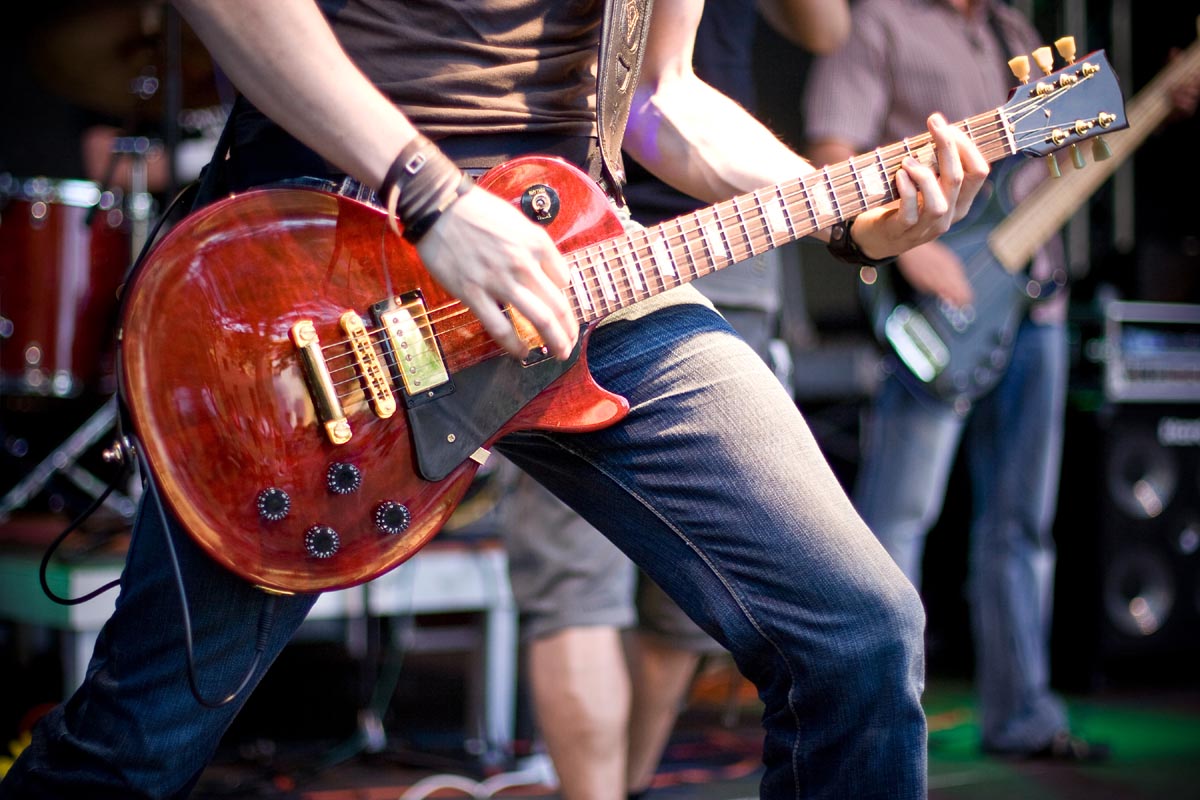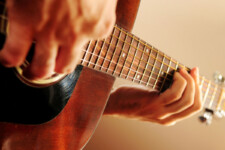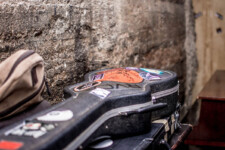Can Playing Guitar Cause Hearing Loss? (Acoustic & Electric)
In perhaps the least punk rock question we’ve answered so far on this website, we ask if playing guitar can do damage to your hearing.
You probably already know the answer but would rather ignore the very apparent fact that any type of noise isn’t great for your ears, especially if you listen to it for hours a day.
Extended periods of play are the biggest culprit for hearing loss for guitarists and musicians in general, but just how loud do you have to play to start causing the hearing loss? And how long can you play for before rocking out becomes unsafe?
Hearing loss is very serious. It’s one of the few areas of the medical world where there are no cures, once you’ve damaged your ears there is no way to fix them.
Right now is the best time to answer the question that most of your favorite guitarists probably asked way too late.

Are Guitars Loud Enough to Cause Hearing Loss?
Guitars can absolutely be loud enough to damage cause hearing loss. For your guitar to start causing hearing loss depends on a few factors such as how loud you are playing and how long you play for.
To understand the risk of hearing loss from playing guitar you need to understand the levels of volume our ears can withstand. The CDC outlines that the danger zone begins at 80 dB of sound. At this volume around 2 hours of playing may start to damage your ears.
A good rule of thumb to work out if your playing your guitar at a dangerous volume is whether you need to raise your voice to be heard from an arm’s length away. But there are more technical ways to figure it out such as finding out how loud your guitar amp is based on its wattage.
But more on that later.
The simple answer is yes. Playing guitar for just a couple of hours at a high volume does lasting damage to your ears.
Acoustic Guitar Volume (When You Hold Them)
When you think about loud instruments you probably aren’t going to think of an acoustic guitar. Known to be one of the most relaxing instruments to listen to; the thought that playing and listening to an acoustic guitar could cause hearing damage seems a bit ridiculous!
The truth is acoustic guitars are capable of reaching ear damaging volumes. To reach these levels you need to be really going for it though so the concern isn’t as great as that when playing an amplified electric.
An acoustic guitar played at maximum intensity is on average going to reach a volume level between 82 dB and 86 dB. Remember that damage can because by sounds above 80 dB if heard for a prolonged amount of time.
This is also the volume taken from standing in front of the guitar. When playing an acoustic guitar the soundhole is projecting away from your ears so they’re not taking the full force of the sound that someone would take if they were standing in front of the guitarist listening.
Can an Acoustic Guitar Cause Hearing Loss (Unplugged)?
While acoustic guitars do reach the threshold for dangerous volume levels you shouldn’t be too concerned.
To get into hearing loss territory while playing an acoustic guitar you would have to be strumming it as hard as you can for hours at a time. And I mean really slamming it. ‘Normal’ playing on an acoustic usually ranges between the safer 70-80 dB range.
So unless you’re banging out chords at full pelt, your acoustic will typically stay within a safe volume range and your ears will be ok!
Electric Guitar Volume (At the Amplifier)
Playing amplified electric guitars is where the real danger of shred induced hearing damage can occur.
The average guitar amp has a loudness of 115 dB, way above the recommended limit for safe levels of volume. This measurement is taken 1 meter away from the amp.
This measurement is regardless of the wattage of your amp. In fact, wattage doesn’t impact the loudness of your guitar in the way you would expect it to.
The interaction between watts and decibels is a strange one. It would seem logical that doubling your watts would double your decibels, this is far from the case. In fact, doubling your wattage will only give you a 3 dB rise in volume.
For example, if you took a 50 watt amp and sat it beside a 100 watt amp the difference in decibels would only be 3 dB. To get double the volume of the 50W amp, you would need an amp with 10 times the power. That’s 500 watts!
This also applies to changing the volume of your amp. The difference between playing your amp at full volume and at half volume will only be 3 decibels. So don’t assume your ears are safe by just turning your amp down a bit.
Do High Notes on Guitar Cause More Hearing Loss?
The human ear is a sensitive instrument! Low and High frequencies affect your ears differently, with high frequencies being more dangerous to your ears than low ones.
In comparison to low frequencies; high frequencies are quicker to damage the cilia in your ears, these are the little hairs that line the inside of your ears. This could be applied to the different pitches made when playing the higher notes on your guitar.
This is especially apparent when using distortion and overdrive effects. Overdrive can make these high notes play at an even higher frequency, you can usually notice it as a piercing sound that rings out through the note.
How Long Can You Play Guitar Before Hearing Loss Starts?
The amount of time you can play guitar before hearing loss starts is dependent on the volume and how far away from the amp you’re playing from.
If you’re playing at home on an amplifier above 50 watts hearing damage can start appearing anywhere between 5 minutes to 2 hours. Even the slightest changes in volume can have a big impact on how much damage you’re doing to your ears.
Hearing damage is hard to measure and irreversible so the best way to work out how long you should be playing for is to self-monitor how you feel after a session of guitar playing.
If you find that your ears have buzzing or ringing in them, or that sounds sound muffled or quieter than usual – you are most likely playing too loud for too long!
For acoustic guitars, you’re pretty safe. The only thing to watch out for is if you’re playing vigorously for more than 2 hours this is around the time that hearing damage can start to occur with acoustic guitar playing.
How To Protect Your Hearing When Playing Guitar
While playing guitar might now sound a bit dangerous, there are plenty of ways to protect your hearing from any damage your passion may cause!
The Best Ear Plugs for Guitar Players
1. Fender Musician Earplugs
If you’re looking for a cheap way to protect your ears then the Fender Musician Earplugs are a great choice. While their super inexpensive they offer great protection and are designed to minimize their effect on the tone of your guitar.
They won’t be as tonally accurate as more expensive earplugs but they’ll be way better than the ones that get handed out before concerts.
They offer noise reduction of -27 dB which should bring you under the threshold for hearing damage in most practice situations. These are a fantastic affordable option for home players but don’t expect them to give you the most precise sound that is necessary when playing live.
2. Eargasm High Fidelity Earplugs for Musicians & Concerts
Eargasm earplugs are made from hypoallergenic silicon, and are designed to lower noise levels by up to 21dB while still allowing you to clearly hear your favorite music.
These are one of the most popular ear plugs on the market, and come in two sizes, meaning that they will fit people with smaller ear canals (like children) as well as adults.
Re-usable, these ear plugs can be cleaned gently with a soft damp cloth, combined with a mild soap or rubbing alcohol.
Eargasm’s are specifically designed to lower noise, not block it – making them a great musicians choice. People also comment that they are extremely comfortable to wear.
3. Loop Experience Pro Earplugs for Musicians
Loop Experience ear plugs come with a variety of silicon and foam tips in 4 different sizes, and reduce sound levels by up to 18dB, and this can be increased by 5dB by adding the foam tips.
The really smart thing about these ear plugs is that you can change how much noise reduction you want easily and quickly by just using the silicon plugs alone, or coupling them with the foam buds that come in the same pocket-friendly shaped case.
The loops come in a choice of black or silver for different looks.
Other Ways to Protect Your Hearing Playing Guitar
Turn Down the Volume
The most straightforward piece of advice for protecting your ears is…
TURN DOWN THE VOLUME !
This should be pretty self-explanatory but if you can’t hear yourself speak you’re playing too loud. Especially if you’re playing for long intervals.
This brings us to our next tip.
Play for Shorter Intervals
The idea of playing in shorter intervals isn’t very rock and roll. It can also be hard to pull yourself away from your guitar if you’re in a flow state of guitar bliss.
But playing guitar in intervals is a great way to reduce the harm being done to your ears and to keep a check on how your ears are feeling after playing.
Splitting your guitar sessions up into at most 30 minute bursts gives you time to notice any discomfort or changes in your ears and hearing.
If after a session you find your ears to be sore, displaying any signs of ringing then you should probably call it a day (or invest in earplugs).
Giving your ears a break is essential for preventing damage as in most cases it’s the consistency of high volume sounds that causes damage, not the initial volume itself. Unless you’re playing at below 100 dB, this volume can cause damage in a matter of minutes.
Move Further Away from the Amp
The distance you are from the source of a sound has a massive impact on how much of the intensity of that sound your ears have to withstand.
At 1 foot away from a speaker or amp, you’re getting 100% of the intensity of the sound. Moving a mere 2 foot away from the speaker reduce that intensity to 25%. By the time your 4 feet away that intensity is at 6%.
So while you can pay to get earplugs a far cheaper option for looking out for your ears is to simply not be so close to while your jamming!







